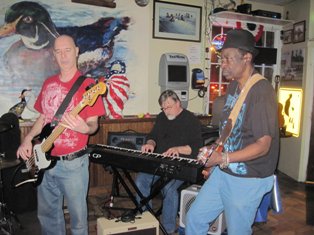
After interviewing a number of Jam Masters, I decided to present the view from the cheap seats. On my quest to reacquaint myself with the bass guitar, I participated in a lot of different jams over the last few months. I spent most of that time socializing. The hard truth is that for every three hours spent at a session, most jammers average fifteen minutes (two to three songs) playing time. You need to come early to get a good spot on the sign up list (unless you're connected) and common courtesy dictates that you stay at least one set after you play so it doesn't look like a hit and run. That said, many players relish the chance to get out of the house once or twice a week (nod and a wink to the King of the Jammers)!
The house band defines the session. If I don't want to hear the house band, I don't want to go to the jam. Some leaders rotate the players; others keep the personnel the same. Although it becomes a chore for the leader to constantly book different musicians, I like the variety. If I have to listen to the same players each week, they should at least vary the tunes. Opening sets run from fifteen minutes to an hour. Smart leaders realize the jam is not about them and keep the house set short or integrate other players during the songs. Most jammers resent when the house band gets up for a second set in the middle of the night. They also don't like it when the jam starts late because the band doesn't arrive on time or they don't want to play to a half empty house.
The jam master faces a notoriously difficult task when mixing and matching players for a set. Some jammers take their fate into their own hands and sign up as a group. When I first took up bass again, I gladly played with anyone. But after months of practicing for up to two hours a night, I selfishly wanted to play with better musicians -- or at least those who studied their craft. I vowed that if I got called to perform a song I didn't know, I would go home and learn it. Unfortunately, many people do not share my work ethic. They don't mind playing the same tune week after week without every bothering to listen to the record. A true jam master will mix the players so that the novices learn from the veterans but don't pull the set apart. The best house sidemen will gladly rush up on stage to help out a flailing group or add some much needed balance. However, some sidemen only want to play the house set. Other sidemen play so much they cut into the jammers' opportunity.
The best leaders manage time carefully. They don't leave the band stand and socialize for fifteen minutes before sending up the next batch of players. Along that line, they limit each set to three songs or fifteen minutes. As we all know, one song can last for half an hour! Most players get to perform at least one full set. Unfortunately, some vocalists may only get called up for one song. That seems unfair.
At the end of the day, jammers vote with their feet. They want to feel valued. After all, they buy at least two drinks and stay at least two hours in order to perform for fifteen minutes. Disgruntled players don't return. From Sunday through Thursday, I can find at least two jams per night. Since I live in White Plains and believe in keeping it local, I mostly stick around here (Elements, Wicked Wolf, Sports Page). But I make the occasional trip to Elmsford (Pete's Saloon), Mamaroneck (Duck Inn), Pleasantville (Lucy's Lounge), and Bronxville (J.C. Fogarty's) in New York and to Stamford (Monster B's, Seaside Tavern), and Georgetown (Georgetown Saloon) in Connecticut. Frankly, I would go to J.C. Fogarty's more often if I didn't get lost each time, LOL.
And one final point. The jams would be nothing without the non-playing audience who fill the cash register. Special thanks to the tireless photographers who post all of their great shots on Facebook and even tag them -- John Apicelli, Amy Kerwin, and Honey McGarvie (who took the photo at the top of this article.)
©2011 Roger Zee